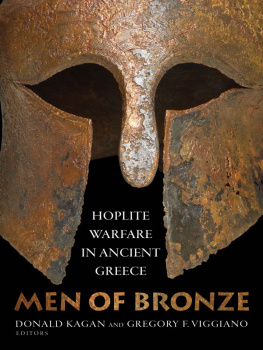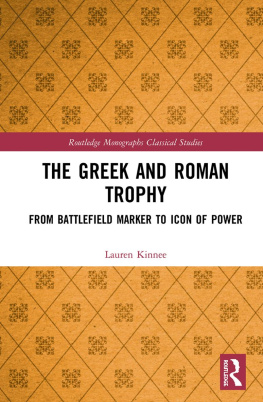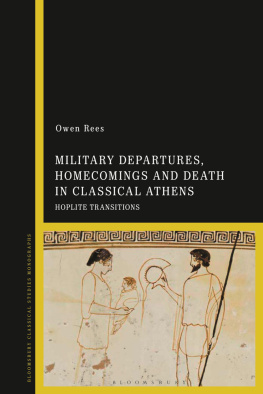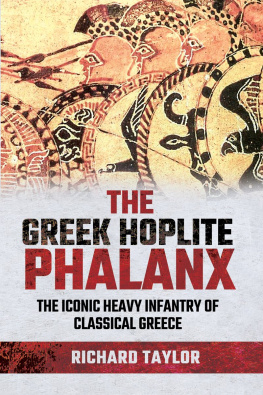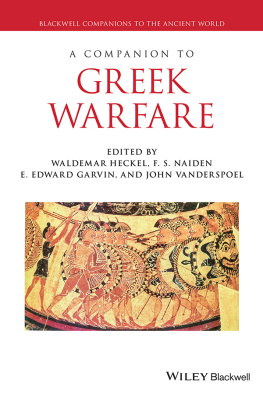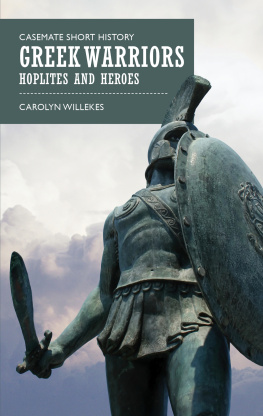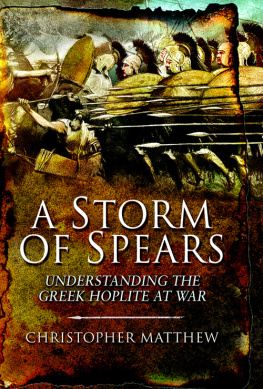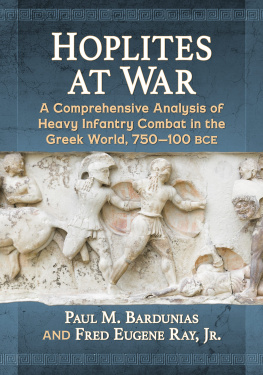
MEN OF BRONZE
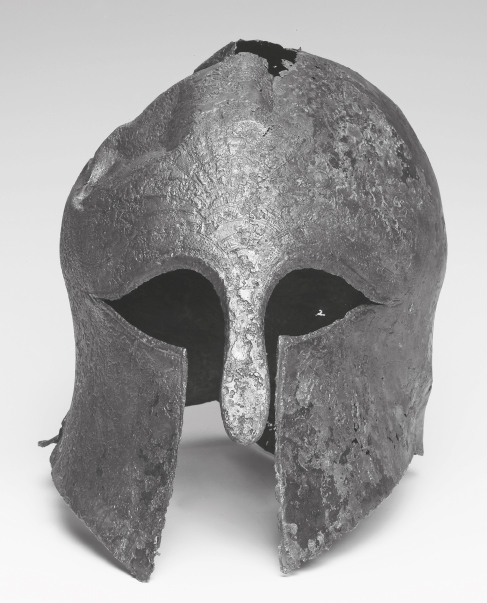
In 2007, a Greek helmet of gilded bronze was recovered from Haifa Bay, Israel, during commercial dredging operations. Following conservation by the Israel Antiquities Authority, the helmet emerged as a remarkable example of the type of closed Corinthian helmet traditionally associated with Greek hoplites. The helmet had been shaped by a master craftsman from a lost-wax bronze casting less than 2 mm thick, with a riveted nose guard 11 mm thick to provide extra protection to the warriors face. A glittering coat of gilding covered the exterior, some of which still remains to testify to the wealth and elite status of the helmets original owner. Rich decoration had been applied with chasing hammers and punches: two snakes curling above the eye-holes; a palmette or peacocks tail on the forehead; and heraldic lions on the cheek-pieces. Such elaborate decoration is rare on Corinthian helmets, though more common in the Archaic period than in the fifth and fourth centuries BC. This spectacular piece of early Greek metalworking is now on display at Israels National Maritime Museum in Haifa, which overlooks the waters where the helmet lay hidden for some 2600 years. Photo by Warhaftig Venezian Photographers for the Maritime Museum of Haifa. Text description courtesy of Israel Antiquities Authority and Jacob Sharvit.
MEN OF BRONZE
Hoplite Warfare in Ancient Greece
EDITED BY DONALD KAGAN AND GREGORY F. VIGGIANO
PRINCETON UNIVERSITY PRESS PRINCETON AND OXFORD
Copyright 2013 by Princeton University Press
Published by Princeton University Press, 41 William Street,
Princeton, New Jersey 08540
In the United Kingdom: Princeton University Press, 6 Oxford Street,
Woodstock, Oxfordshire ox20 1tw
press.princeton.edu
Cover Photograph: Haifa Bay helmet. Photo by Warhaftig Venezian
Photographers for the Maritime Museum of Haifa. Courtesy of
Israel Antiquities Authority and Jacob Sharvit.
All Rights Reserved
Fourth printing, and first paperback printing, 2016
Paperback ISBN: 978-0-691-16845-6
The Library of Congress has cataloged the cloth edition as follows:
Men of bronze : hoplite warfare in ancient Greece / edited by Donald Kagan and Gregory F. Viggiano.
pages cm
The papers published in this volume resulted from a conference on early Greek hoplite warfare held at Yale University in April 2008.
Includes bibliographical references and index.
ISBN 978-0-691-14301-9 (hardcover : alk. paper) 1. Military art and scienceGreeceHistoryTo 1500Congresses. 2. SoldiersGreeceHistoryTo 1500Congresses. 3. GreeceHistory, MilitaryTo 146 B.C.Congresses. 4. Weapons, AncientGreeceCongresses. 5. Armor, AncientGreeceCongresses. I. Kagan, Donald, author, editor of compilation. II. Viggiano, Gregory, author, editor of compilation.
U33.M46 2013
355.4738dc23
2012047892
British Library Cataloging-in-Publication Data is available
This book has been composed in Garamond Premier Pro
Printed on acid-free paper.
Printed in the United States of America
10 9 8 7 6 5 4
CONTENTS
DONALD KAGAN AND GREGORY F. VIGGIANO
|
DONALD KAGAN AND GREGORY F. VIGGIANO
|
DONALD KAGAN AND GREGORY F. VIGGIANO
|
GREGORY F. VIGGIANO AND HANS VAN WEES
|
PAUL CARTLEDGE
|
ANTHONY SNODGRASS
|
KURT A. RAAFLAUB
|
GREGORY F. VIGGIANO
|
PETER KRENTZ
|
ADAM SCHWARTZ
|
JOHN R. HALE
|
LIN FOXHALL
|
HANS VAN WEES
|
VICTOR DAVIS HANSON
|
LIST OF FIGURES
PREFACE
DONALD KAGAN AND GREGORY F. VIGGIANO
The papers published in this volume resulted from a conference on early Greek hoplite warfare held at Yale University in April 2008. The idea for the conference grew out of a spirited debate that took place following a panel presentation at the American Philological Associations annual meeting at San Diego in January 2007, New Perspectives on Ancient Warfare. From the audience, Gregory Viggiano argued in favor of the theses of Victor Davis Hansons The Western Way of War and The Other Greeks against the positions of Peter Krentz and Hans van Wees. These scholars later agreed to continue the debate in a formal setting. Viggiano then discussed with Donald Kagan the unique possibility of having the worlds leading scholars on the subject air out their differences face-to-face at Yale. Further discussions with Paul Cartledge helped bring about the Yale conference. The conference panels debated a variety of issues surrounding the hoplite orthodoxy and the attempts to revise it: (1) questions concerning the origins of the tactics and weapons employed by the Greek hoplite (heavily-armed infantryman), fighting in massed formation on behalf of his autonomous city-state (polis); (2) questions about the political, economic, and social significance of the new mode of fighting; and (3) questions regarding the impact hoplite warfare had on Greek culture in general. All these issues have in recent years been at the center of one of the liveliest and most important controversies in the fields of classical studies, ancient political history, and ancient military history.
We want to thank everyone who contributed to the success of the Yale conference, which was held at the Hall of Graduate Studies on the Yale campus. Our first concern in putting together an international workshop was making sure that the scholars would be willing to come and debate, so we are grateful to all the participants for sharing our enthusiasm for the idea. We were very fortunate to have Susan Hennigans superb assistance in arranging the travel and stays of the participants, and in taking care of all the logistics (meals, programs, audiovisual equipment, etc.) for the event. One scholar remarked that everyone got along so well because there was so much good food to eat. The panel sessions were well attended by faculty, undergraduate and graduate students from Yale, as well as faculty from Sacred Heart University, especially the Department of History. A number of scholars and graduate students from universities as far away as the West Coast came to attend the sessions, in addition to people from the New Haven community. Therefore, we owe special thanks to International Security Studies (ISS) at Yale, as well as the Yale Classics Department; for without their kind generosity there would not have been any conference. We make special mention of Ted Bromund of ISS and his dedication to the project, and the support of Professor Christina Kraus, the chair of Yale Classics. Rob Tempio of Princeton University Press has given invaluable support and inspiration at every stage in the production of this volume.
INTRODUCTION
DONALD KAGAN AND GREGORY F. VIGGIANO
The study of ancient Greek warfare begins with what scholars might infer about fighting techniques from the archaeological remains of the late Bronze Age (16001100 BC). It appears that, similarly to the situation in the contemporary Near East, the war chariot was the main offensive arm of the kings military. But during the chaos that attended the collapse of Bronze Age civilization, infantry seems to have become capable of breaking the charges of the palaces chariot forces. The ensuing period from the eleventh to the eighth century, which scholars often call the Dark Age, is notable to the military historian for the introduction of iron weapons. However, to the ancient Greeks themselves this was the Age of Heroes, and the bard Homer was its most famous witness.
Next page
